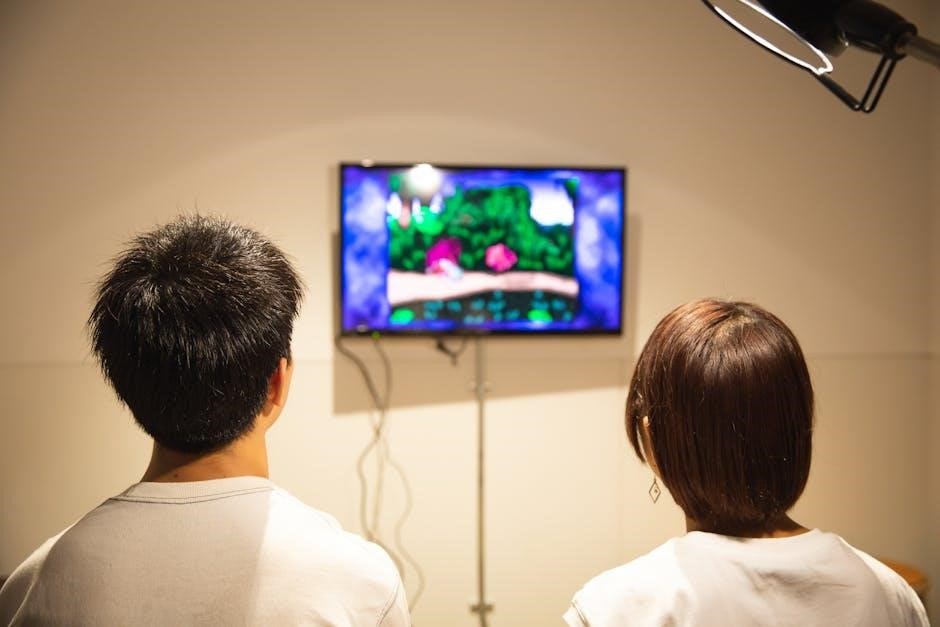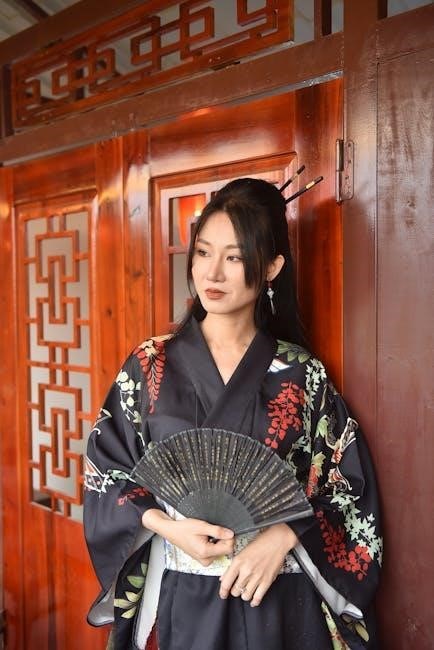Overview of Japanese TV Programming
Japanese TV offers diverse programming, from dramas and anime to variety shows, providing cultural insights and entertainment. Program guides help navigate schedules, aiding viewers in selecting shows that suit their interests and language learning goals.
Japanese television features a diverse range of channels, each catering to specific audiences and genres. Major networks like NHK, Nippon TV, TV Asahi, TBS, and Fuji TV dominate the landscape, offering a mix of dramas, anime, variety shows, news, and sports. NHK, as the public broadcaster, focuses on educational and cultural content, while commercial channels like Nippon TV and TV Asahi emphasize entertainment, including popular dramas and anime. TBS and Fuji TV are known for their variety programs and live entertainment. These channels provide a rich variety of programming, reflecting Japan’s vibrant culture and catering to both domestic and international viewers. With advancements in technology, many of these channels are now accessible globally through streaming services and specialized platforms, making Japanese TV more accessible than ever.
History of TV Broadcasting in Japan
Television broadcasting in Japan began in 1926 with experimental transmissions by NHK, the national public broadcasting organization. Regular TV broadcasts commenced in 1950, with NHK leading the way as the country’s first television network. Commercial broadcasting followed in 1953 when Nippon TV received its license. The 1960s marked a significant milestone with the introduction of color TV, coinciding with the 1964 Tokyo Olympics. Over the decades, Japanese TV evolved to include a wide range of genres, from dramas and anime to variety shows, solidifying its role as a cultural and entertainment hub. The transition from analog to digital broadcasting in 2011 further enhanced viewing quality and accessibility. Today, Japanese TV continues to innovate, blending traditional programming with modern streaming technologies to reach global audiences. This rich history reflects Japan’s technological advancements and cultural storytelling through television.
Popular Genres in Japanese TV Shows
Japanese TV programming features a diverse array of genres that cater to various audiences. Dramas, known as “Jidaigeki” for historical series and “Josei” for women-focused stories, are highly popular and often depict intricate emotional narratives. Anime, a globally recognized genre, dominates both children’s and adult programming, offering vibrant storytelling and unique art styles. Variety shows, or “Bara-ety”, blend comedy, games, and celebrity appearances, providing light-hearted entertainment. Reality TV and game shows also attract large viewerships, often incorporating cultural elements. News and documentary programs are equally prominent, offering insights into current events and societal issues. Additionally, sports and music programs are well-received, showcasing Japan’s vibrant athletic and musical culture. These genres collectively reflect Japan’s rich cultural heritage and modern entertainment trends, making Japanese TV a versatile and engaging platform for both local and international audiences.

Types of TV Programs in Japan
Japanese TV features a wide variety of programs, including dramas, anime, variety shows, news, and documentaries. These genres cater to diverse audiences, ensuring broad appeal and cultural engagement.
Dramas and Their Cultural Significance
Japanese dramas, known as “J-dramas,” play a pivotal role in the country’s television programming. They often depict historical periods, social issues, and everyday life, offering viewers a glimpse into Japan’s cultural fabric. Many dramas are adapted from popular manga, novels, or real-life events, ensuring relatability and emotional depth. Historical dramas, or “jidaigeki,” are particularly popular, showcasing samurai stories and traditional values. Modern dramas frequently address contemporary themes like workplace challenges, family dynamics, and technological advancements, resonating with both local and international audiences. These shows not only entertain but also serve as a window into Japan’s societal norms and values. Their storytelling and production quality have made them a staple in global streaming platforms, further enhancing their cultural impact and appeal. Dramas remain a cornerstone of Japanese TV, reflecting and shaping societal perceptions while providing compelling narratives for diverse audiences.
Anime: A Global Phenomenon
Anime, a cornerstone of Japanese television, has transcended borders to become a global cultural phenomenon. Originating in Japan, anime encompasses a wide range of genres, from action-packed adventures to heartfelt romances, catering to diverse audiences. Shows like “Dragon Ball” and “Naruto” have gained international acclaim, while studios like Studio Ghibli produce critically acclaimed films that resonate worldwide. Anime’s vibrant visuals, intricate storytelling, and universal themes have made it a staple in global entertainment. Japanese TV networks, such as TV Asahi, heavily feature anime, contributing to its widespread popularity. The rise of streaming platforms has further amplified its reach, allowing fans to access a vast library of anime content. As a result, anime has become a significant cultural export for Japan, fostering global fandom and influencing various aspects of media and pop culture. Its enduring appeal continues to shape the entertainment landscape both in Japan and internationally.
Variety Shows and Entertainment
Variety shows are a cornerstone of Japanese television, offering a unique blend of entertainment, humor, and cultural insight. These programs often feature celebrity guests, comedy sketches, and interactive games, making them highly engaging for both domestic and international audiences. Shows like “Gaki no Tsukai” and “Bistro SMAP” have gained cult followings, showcasing Japan’s distinct sense of humor and creativity. Many variety shows incorporate elements of Japanese pop culture, such as music performances by J-pop idols and comedic challenges that highlight everyday life. They also serve as platforms for cultural exchange, introducing viewers to traditional customs and modern trends. With their lively format and diverse content, variety shows remain a staple of Japanese TV programming, appealing to a wide range of viewers and providing endless entertainment options.

Major TV Networks in Japan
NHK, Nippon TV, and TV Asahi are leading networks, offering diverse programming. NHK provides public broadcasting, while Nippon TV and TV Asahi focus on entertainment, anime, and cultural content.
NHK: The Public Broadcasting Network
NHK is Japan’s public broadcasting organization, offering high-quality, advertisement-free content. It provides a wide range of programs, including news, documentaries, cultural shows, and educational content. NHK is known for its impartial journalism and deep dives into social issues. The network also produces historical dramas and traditional music performances, showcasing Japan’s rich cultural heritage. NHK World-Japan, its international service, broadcasts globally, making Japanese culture and news accessible worldwide. With a focus on education and public service, NHK plays a vital role in preserving and promoting Japanese traditions while keeping audiences informed. Its programming caters to diverse interests, ensuring there’s something for everyone, from locals to international viewers.
Nippon TV: A Pioneer in Japanese Broadcasting
Nippon TV, established as Japan’s first commercial broadcaster, has been a trailblazer in television history. It pioneered innovative programming, including early color TV experiments and international broadcasts, such as covering the JFK assassination. Today, Nippon TV continues to lead with popular dramas, variety shows, and anime. Its diverse lineup attracts a broad audience, both domestically and internationally. The network’s commitment to quality content has made it a household name, blending entertainment with cultural relevance. Nippon TV’s influence extends beyond broadcasting, owning platforms like Hulu Japan, ensuring its content reaches global viewers. Its legacy as a pioneer remains strong, shaping the future of Japanese television with cutting-edge productions and strategic innovations.
TV Asahi: Leader in Anime and Drama
TV Asahi is a prominent Japanese television network renowned for its high-quality productions, particularly in anime and drama. It has been instrumental in shaping Japan’s entertainment landscape. The network is celebrated for its captivating anime series, such as Attack on Titan and Fairy Tail, which have garnered global acclaim. Additionally, TV Asahi produces compelling dramas that resonate with both domestic and international audiences. Its programming often blends rich storytelling with cultural depth, making it a favorite among viewers. The network’s commitment to innovation and excellence has solidified its position as a leader in Japanese broadcasting. TV Asahi’s content not only entertains but also serves as a gateway to Japanese culture, making it a must-watch for fans of anime and drama worldwide.

TV Program Guides and Schedules
Japanese TV program guides offer detailed schedules, helping viewers navigate various channels and genres. Online resources and mobile apps provide easy access to program listings, enhancing viewer convenience significantly.

How to Navigate Japanese TV Guides
Navigating Japanese TV guides can be streamlined using online resources like Yahoo TV Guide or TBS Program Catalog, which offer detailed schedules and program listings. These guides often feature icons or tags to categorize shows by genre, such as drama, anime, or variety, making it easier to find content of interest. Users can search for specific programs, filter by time slots, and even access past broadcasts. Mobile apps like G-Guide provide on-the-go access, enabling viewers to plan their viewing schedules efficiently. Additionally, many guides offer multilingual support, catering to both local and international audiences. By utilizing these tools, viewers can effortlessly explore Japan’s rich TV programming, ensuring they never miss their favorite shows or discover new ones aligned with their preferences.
Online Resources for TV Schedules
Several online resources simplify accessing Japanese TV schedules, catering to both local and international audiences. Websites like Yahoo TV Guide and TBS Program Catalog provide detailed listings, allowing users to search by genre, time, or specific programs. NHK World-Japan’s schedule is also available online, offering global viewers a glimpse into its diverse programming. Mobile apps such as G-Guide further enhance accessibility, enabling users to browse schedules on the go. These platforms often include features like program categorization and reminders, making it easier to track favorite shows. Additionally, some services offer archives of past broadcasts, giving viewers flexibility in their watching habits. These resources are indispensable for anyone looking to explore Japanese television, ensuring they stay updated on the latest programs and never miss an episode of their preferred content.
Mobile Apps for TV Program Guides
Mobile apps have revolutionized how viewers access Japanese TV schedules, offering convenience and personalized features. Apps like G-Guide provide comprehensive program listings, allowing users to search by genre, time, or channel. Many apps include reminder functions, ensuring viewers never miss their favorite shows. Additionally, some platforms, such as those linked to the J Prime TV box, enable users to stream live Japanese channels or access on-demand content. These apps often feature user-friendly interfaces, making it easy to navigate through schedules and discover new programs. Regular updates ensure that the information remains accurate and up-to-date. With the rise of mobile technology, these apps have become essential tools for both local and international audiences seeking to enjoy Japanese television content seamlessly.

Benefits of Watching Japanese TV
Watching Japanese TV provides cultural insights, language learning opportunities, and diverse entertainment, offering a valuable and enjoyable experience for global audiences.
Cultural Immersion Through TV
Japanese TV offers a unique gateway to cultural immersion, allowing viewers to explore the country’s traditions, customs, and modern lifestyle. From historical dramas to contemporary variety shows, programs showcase Japan’s rich heritage and societal norms. Audiences can gain insights into festivals, traditional clothing, and historical events through detailed storytelling. Additionally, reality TV and documentaries provide a glimpse into everyday life, highlighting the blend of modernity and tradition. Language learners benefit from exposure to native speech patterns and regional dialects. The emotional depth of Japanese dramas and the humor in variety shows create a relatable experience, fostering a deeper connection to the culture. Overall, Japanese TV serves as an engaging tool for cultural understanding and appreciation, making it accessible to global audiences.
Language Learning via TV Programs
Japanese TV programs are an invaluable resource for language learners, offering exposure to native speech, pronunciation, and everyday expressions. Dramas, variety shows, and anime provide contexts that mirror real-life conversations, helping viewers grasp nuanced language use. The repetition of phrases in dramas and the clear dialogue in variety shows make them ideal for improving listening skills. Additionally, programs often feature regional dialects, exposing learners to diverse linguistic variations. Subtitles in Japanese can aid in reading comprehension, while the visual cues enhance understanding. Language learners can also pick up cultural references and idiomatic expressions, which are essential for fluency. Regularly watching Japanese TV fosters familiarity with natural speaking speeds and tones, making it easier to engage in conversations. This immersive approach complements traditional learning methods, enriching one’s language proficiency in an engaging and authentic way.
Entertainment for All Audiences
Japanese television caters to a wide range of audiences, offering diverse genres that ensure everyone finds something engaging. From historical dramas to quirky game shows, the programming reflects Japan’s vibrant culture and creativity. Dramas often focus on intricate storytelling, appealing to adults, while anime captures the imaginations of younger viewers and global fans. Variety shows blend humor, music, and celebrity appearances, making them a favorite for families. Sports enthusiasts can enjoy live broadcasts of popular events, while food and travel programs highlight Japan’s culinary delights. The diverse lineup ensures that viewers of all ages and interests can find entertainment tailored to their preferences. This variety not only appeals to domestic audiences but also attracts international viewers, making Japanese TV a global entertainment phenomenon. Its ability to balance tradition and modernity ensures universal appeal, keeping audiences captivated worldwide.

Accessing Japanese TV Abroad
Japanese TV can be accessed globally via streaming services, VPNs, and specialized TV boxes, allowing international fans to enjoy diverse programming, including dramas, anime, and variety shows, anywhere in the world.
Streaming Services for Japanese TV
Streaming services have made Japanese TV accessible worldwide, offering a wide range of programs. Platforms like Netflix, Hulu Japan, and Amazon Prime Video feature popular dramas, anime, and variety shows. Disney+ also includes select Japanese content. These services provide subtitles or dubbing, catering to international audiences. Additionally, NHK World-Japan streams cultural and news programs for free. Many platforms offer simulcasting, allowing viewers to watch new episodes as they air in Japan. With these services, fans can enjoy Japanese TV programming, including hit titles like The Naked Director and Demon Slayer, from anywhere in the world, making it easier than ever to immerse in Japanese culture and entertainment.
Using VPNs to Access Regional Content
VPNs are a popular solution for accessing Japanese TV content restricted to specific regions. By masking your IP address, VPNs make it appear as though you’re viewing from within Japan, bypassing geo-blocking. This allows access to platforms like Hulu Japan, NHK World, and other regional services. Many VPNs, such as ExpressVPN or NordVPN, offer servers in Japan, enabling seamless streaming. While this method is effective, it’s important to note that not all VPNs work perfectly, as some streaming services employ strict geo-blocking measures. Additionally, using a VPN may slightly slow down your internet connection. However, for fans of Japanese TV, VPNs provide a reliable way to enjoy live broadcasts, on-demand programs, and exclusive content from anywhere in the world. Always ensure compliance with local laws and streaming platform terms of service when using VPNs.
Specialized TV Boxes for International Viewers
Specialized TV boxes are a popular solution for international viewers seeking access to Japanese TV channels. These devices, such as the J Prime TV Box, allow users to watch Japanese broadcasts outside of Japan; They often come preloaded with apps and channels, providing access to NHK, Nippon TV, and other major networks. Some boxes even offer features like recording shows aired in the last 30 days, making it convenient for viewers to catch up on missed programs. These devices are particularly appealing to expatriates and enthusiasts of Japanese culture. While some boxes may require a subscription, they offer a user-friendly way to access a wide range of Japanese content. Additionally, they support multiple languages, catering to both native Japanese speakers and international audiences. This technology bridges the gap for global fans of Japanese TV, ensuring they never miss their favorite shows.

Viewer’s Guide to Japanese TV
A viewer’s guide to Japanese TV helps audiences discover recommended programs, navigate schedules, and explore diverse genres like dramas, anime, and variety shows.
Recommended Programs for Foreign Viewers
For foreign viewers, Japanese TV offers a wide range of engaging programs that cater to diverse interests. Popular dramas like “The Naked Director” and “DOPE Narcotics Control Department” provide compelling storylines and cultural insights. Anime remains a global favorite, with shows like “Attack on Titan” and “Demon Slayer” attracting millions worldwide. Variety shows such as “Gaki no Tsukai” blend humor and entertainment, making them accessible to non-native speakers. Additionally, programs like “NHK WORLD-JAPAN” offer documentaries and travelogues that showcase Japan’s rich culture and history. Many of these shows are available on streaming platforms like Netflix, Hulu, and NHK WORLD-JAPAN, making it easier for international audiences to enjoy Japanese programming. These recommendations provide a great starting point for anyone looking to explore Japanese TV.
How to Choose the Right Programs
Choosing the right Japanese TV programs can be tailored to your interests and preferences. For drama enthusiasts, popular titles like “The Naked Director” and “DOPE Narcotics Control Department” offer engaging storylines. Anime fans can explore global hits like “Attack on Titan” and “Demon Slayer”. Variety shows such as “Gaki no Tsukai” provide humor and entertainment, while “NHK WORLD-JAPAN” documentaries showcase Japan’s culture and history. For language learners, programs with subtitles or simpler dialogue are ideal. Use TV guides like G-Guide or apps to filter genres, such as dramas, anime, or variety shows. Streaming platforms like Netflix and Hulu also offer curated lists for international viewers. By combining personal interests with these tools, you can easily find programs that suit your tastes and goals.
Understanding Program Categories
Japanese TV programming is categorized into diverse genres, making it easy for viewers to find content that matches their preferences. Dramas often focus on cultural themes, while anime spans fantasy, romance, and action. Variety shows blend comedy, games, and celebrity appearances, offering light-hearted entertainment. News and documentaries provide insights into current events and historical contexts. Sports and reality TV cater to fans of competition and real-life stories. Kids’ programs are designed for younger audiences, promoting education and fun. Understanding these categories helps viewers navigate guides and streaming platforms effectively. For example, platforms like Netflix and Hulu label shows by genre, while traditional guides use icons to differentiate between news, dramas, and variety shows. This system ensures that audiences can quickly identify and enjoy programs aligned with their interests.

Future of Japanese TV Programming
The future of Japanese TV programming involves innovation, technological advancements, and global distribution. Streaming platforms, 4K/8K resolution, and international collaborations are reshaping how content is produced and consumed worldwide.

Emerging Trends in Content Creation
Japanese TV programming is embracing cutting-edge trends in content creation, such as 4K and 8K resolution, AI-driven production tools, and immersive storytelling. Streaming platforms are fostering global collaborations, enabling Japanese creators to produce international co-productions. Additionally, interactive content and personalized viewing experiences are becoming more prevalent, catering to diverse audience preferences. These innovations are not only enhancing production quality but also expanding the reach of Japanese television to global audiences, ensuring its relevance in the digital age while preserving its cultural identity.
Impact of Streaming Platforms
Streaming platforms have revolutionized Japanese TV programming by offering on-demand access to a wide range of shows. Services like Netflix and Hulu have introduced Japanese content to global audiences, popularizing genres such as anime and dramas. These platforms have also enabled viewers to watch programs anytime and anywhere, increasing flexibility. Additionally, streaming services have influenced traditional broadcasting by encouraging the development of original content tailored for online consumption. This shift has not only expanded the reach of Japanese television but also provided new opportunities for creators to experiment with innovative formats and storytelling. As a result, streaming platforms are playing a pivotal role in shaping the future of Japanese TV programming.
Technological Advancements in Broadcasting
Japanese TV programming has embraced cutting-edge technology to enhance viewing experiences. High-definition (HD) and 4K/8K resolution broadcasts now offer crystal-clear visuals, setting a new standard for quality. NHK, Japan’s public broadcaster, has been a pioneer in developing 8K broadcasting, providing ultra-high-definition content for select programs. Additionally, advancements in digital broadcasting have improved program guides, allowing viewers to easily navigate and search for shows. The integration of artificial intelligence (AI) in content delivery systems has also personalized viewing experiences, recommending programs based on user preferences. Furthermore, the adoption of virtual production technologies has enabled creators to produce immersive and cost-effective content. These technological innovations are transforming how Japanese TV programming is produced, delivered, and consumed, ensuring a future of high-quality and engaging entertainment for audiences worldwide.

0 Comments